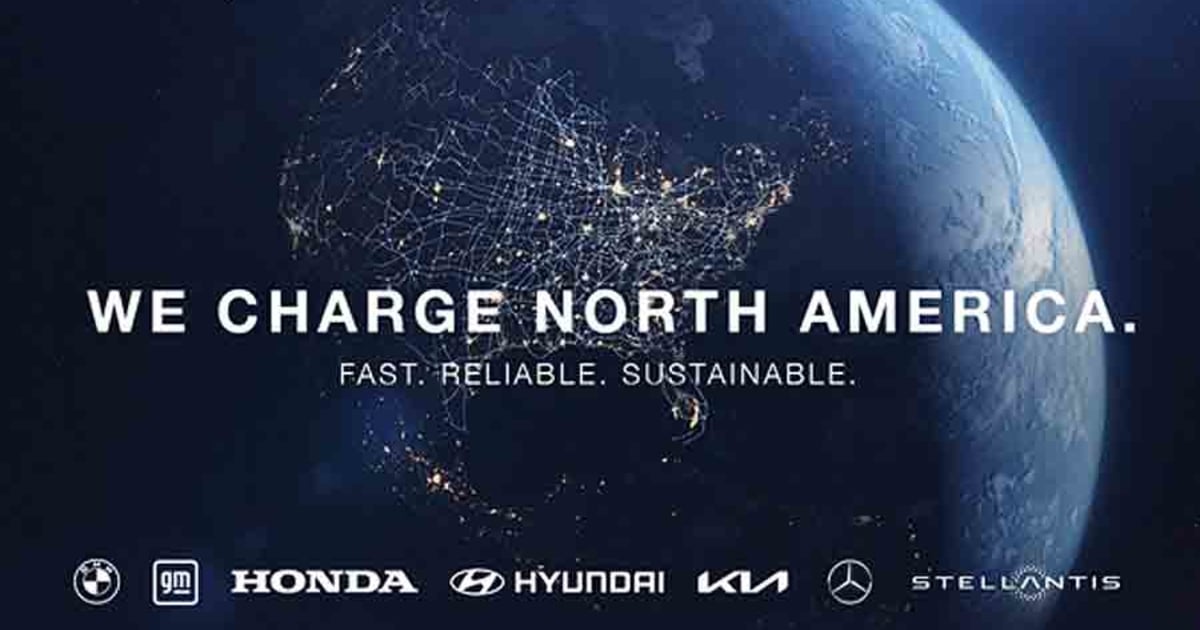
The joint electric vehicle charging network seven major automakers announced this week shows an industry commitment to improve the charging experience — a serious pain point for their customers. But analysts say it is unlikely to dent Tesla’s charging network dominance.
BMW Group, General Motors, Honda, Hyundai, Kia, Mercedes-Benz Group and Stellantis said they will launch their own network of 30,000 fast chargers along highways and in urban areas. The first stations are slated to open next summer and will be available to any EV brand.
Expanding a reliable charging infrastructure is an industry and Biden administration priority. Tesla’s extensive charging network and system reliability give it a leg up over other charging providers. Several automakers in the last few months have announced partnerships with Tesla that allow their EV customers to use Tesla Superchargers without an adapter. The joint venture is another step toward broadening the charging network, and it gives legacy automakers a bigger stake in charging infrastructure, analysts said.
Tesla has more than 22,000 fast-charging ports, compared with fewer than 13,000 for all other networks combined, according to the Department of Energy.
EVAdoption, an EV data firm, estimates that Tesla will have 28,000 fast-charging ports compared with 17,800 from other networks next year. It estimates the automaker joint venture will have 33,000 ports, Tesla will have 60,000 and other networks will have about 56,000 by 2030.
Tesla will maintain a competitive edge, said Loren McDonald, CEO of EVAdoption, helped by its Apple-like ecosystem where everything is designed exclusively for its vehicles.
Legacy automaker partnerships with Tesla demonstrate its older rivals still consider the electric vehicle company “the gold standard” for charging footprint and user experience, said Amaiya Khardenavis, EV charging infrastructure analyst at Wood Mackenzie, an energy research and consulting firm.
Poor charging experience was likely the main driver of the joint venture, he said. Previously, automakers focused on their core business — vehicle sales and service. As they offered more EV models, but consumers struggled to charge them, the companies realized “we have to get into charging to get EVs the market and expedite EV adoption,” Khardenavis said. That must happen even if it means competing with the charging network operators many have already partnered with, he said.
The joint venture is similar to Ionity, a charging network joint venture in Europe by BMW, Ford Motor Co., Hyundai, Mercedes and Volkswagen Group. Ionity’s scale is much smaller than the North American joint venture’s target. Ionity has about 2,600 chargers across 24 countries.
The goal to install 30,000 chargers across North America is a first step, analysts said, and it shows that automakers learned they need to collaborate.
Automaker CEOs emphasized the value of collaboration in their announcements. A strong charging network should be available for all, Stellantis CEO Carlos Tavares said. And it should be “built together with a win-win spirit,” he said.
Still, it will make up only a sliver of the more than 180,000 fast chargers that the National Renewable Energy Laboratory estimates the U.S. will need by 2030.
“Now the hard part is reaching off the highways into the rest of North America,” said Conrad Layson, senior alternative propulsion analyst at AutoForecast Solutions. “Thirty thousand helps us build out the essential charging network along highly traveled routes like the turnpikes, like the interstates. It doesn’t cover what the British call the B roads.”
For the joint venture to be successful, it must apply lessons learned from early entrants in the charging space to improve the locations and number of charge ports, along with reliability, said Sam Fiorani, AutoForecast Solutions vice president for global vehicle forecasting.
J.D. Power said more than 1 in 5 charge attempts failed in the first quarter. Most of those fails were at non-Tesla stations.
“Making sure the new consortium works in the best interest of all will be the toughest obstacle, but it will be beneficial to all players in the long run,” Fiorani said.
The joint venture said it expects to meet requirements to receive funding under the National Electric Vehicle Infrastructure formula. The chargers will have both Tesla’s North American Charging Standard and the rival Combined Charging System plugs and will focus on customer experience.
So far, the plan seems to address many charging issues, Stephanie Brinley, associate director of AutoIntelligence for S&P Global Mobility, said in a statement.
The joint venture “has the benefit of hindsight, of seeing what isn’t working well in today’s charging infrastructure,” she said, “and is taking steps to address those issues.”